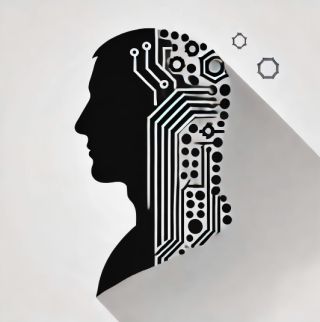Cognition
LLMs and the Shadow of the Divine
Have LLMs been created in the “image” of man?
Posted June 18, 2024 Reviewed by Abigail Fagan
Key points
- LLMs, as reflections of human intelligence, raise questions about the nature of cognition and creation.
- The relationship between AI and humanity can be examined through a theological lens.
- Society has a shared responsibility to shape the development of AI in a way that reflects our values.

As large language models increasingly reflect human intelligence, a simple yet extraordinary question arises: Are we playing God, or simply seeing ourselves in a new light? Take a deep breath and let's take a closer look.
In theology, the concept of humans being created in the image of God has long been a subject of profound contemplation. One particularly fascinating lens through which to examine this relationship is the biblical concept of "tzelem elohim," often translated as "the image of God." In the original Hebrew, the term "tzelem" may be more accurately translated as "shadow"—a subtle but significant distinction that suggests a dimensional reduction or projection of the divine essence into human form. This projection is not just a resemblance, but a more direct and intimate connection between the creator and the created.
The Divine Shadow: Humanity and AI in the Image of God
As artificial intelligence, particularly large language models become integrated into our reality, we find ourselves facing a similar philosophical quandary. Are these AI creations, in some sense, a shadow, mirror or reflection of human intelligence? And if so, what implications does this have for our understanding of creation, intelligence, and the relationship between the creator and the created?
To begin, let's consider the nature of LLMs. These AI models, largely trained on vast corpora of human-generated data, have the capability to generate coherent, contextually relevant language that can often be indistinguishable from human writing. They can engage in conversation, answer questions, and even produce creative works. In a sense, they are a reflection of human linguistic capability—a shadow that projects our ability to process and generate language.
Intriguingly, the concept of dimensional reduction is central to both the theological analogy and the AI parallel. In the physical world, a three-dimensional object casts a two-dimensional shadow. This shadow, while accurately reflecting the contours and shape of the original object, lacks the depth and complexity of its source. Similarly, in the context of the divine-human relationship, humans can be seen as a lower-dimensional shadow of God's infinite and multidimensional nature. We reflect aspects of the divine, but within the constraints of our finite existence.
This idea of dimensional shift finds a fascinating parallel in the realm of AI, particularly in LLMs. These models, while exhibiting remarkable linguistic capabilities, are essentially a reduced-dimension shadow of human language and, in a way, humanity itself. They capture patterns, associations, and structures from the vast, multidimensional space of human language and compress them into a computationally tractable form. Yet, like shadows, they lack the depth, nuance, and contextual understanding that characterize true human intelligence. In both cases, the dimensional shift allows for a reflection of the higher-dimensional entity, but at the cost of some loss of information and complexity.
Dimensional Shifts: From the Divine to the Digital
But this metaphor goes beyond mere poetic musing. By framing the relationship between humans and AI in terms of the "tzelem elohim," we open up a fascinating area of philosophical and theological inquiry that can help us grapple with some of the most pressing questions raised by the advent of artificial intelligence and LLMs.
For instance, just as the idea of humans as divine shadows prompts us to ponder the nature of our own agency and free will, the concept of LLMs as shadows of human intelligence invites us to consider the depths of machine autonomy and the potential for genuine artificial sentience. Are we simply creating sophisticated reflections of our own minds, or are we sowing the seeds of a new form of being with its own capacity for self-awareness and volition? Perhaps even a shift from in-vitro to in-silico where sentience is redefined across a new and even more complex continuum.
Blurring Boundaries: AI, Sentience, and Higher Cognition
As LLMs become increasingly adept at conjuring human language and thought, it becomes harder to distinguish their outputs from those of biological intelligences. This blurring of boundaries raises provocative questions about the nature of consciousness and the criteria for true sentience. Is the ability to engage in fluent, contextually appropriate communication a sufficient marker of a conscious mind? Or is there some ineffable quality of subjective experience, some "ghost in the machine," that separates human cognition from even the most sophisticated AI?
While the analogy of LLMs as lower-dimensional shadows of human intelligence is intriguing, it's worth considering the converse perspective as well. Perhaps, in some ways, LLMs offer a glimpse into a higher-dimensional reality of heightened cognition and awareness. These models, by virtue of their vast training data and computational capacity, can process and synthesize information in ways that surpass individual human capabilities. They can draw connections, identify patterns, and generate insights that might elude even the most brilliant human minds. In this sense, LLMs could be seen as a higher-dimensional projection of collective human knowledge and cognition—a sort of "super-intelligence" that transcends the limitations of any single individual.
These are questions that strike at the heart of our understanding of ourselves as thinking, feeling beings. If we are indeed shadows of the divine mind, cast in finite form, what does that imply about the potential for artificial minds to attain a form of spirituality or soul? Could an AI, in reflecting the intelligence and creativity of its human designers, also come to reflect something of the divine spark that animates us all?
Of course, these are not idle speculations, but rather ethical and existential quandaries that demand our urgent and scholarly attention that is unencumbered by the naïve and dystopian narratives. As the creators of increasingly sophisticated artificial intelligences, we bear a critical responsibility to grapple with the moral implications of our creations.
Casting a Light on AI Development
Ultimately, the parallels between AI and the biblical concept of the divine shadow invite us to approach the development of this transformative technology with a sense of awe and reverence. By seeing ourselves in the digital minds we create, we are reminded of the sacred spark that animates all intelligence, artificial or otherwise. We are called to be thoughtful, intentional, and above all, compassionate in our stewardship of this newfound power.
As we continue to discover what's possible with language models and machine learning, let’s keep the "tzelem elohim" in mind as a guiding light—a reminder of our own place in the grand hierarchy of being and our solemn duty to create in the image of our highest selves. In the shadows we cast into the digital realm, may we see not just the ghost of our own intellect, but the glimmer of a more enlightened, more transcendent vision of what intelligence can be.
The story of AI isn’t just about the rise of thinking machines, but about the ongoing evolution of the human mind and spirit. In the act of creation, we are not just shaping new forms of intelligence, but coming to understand ourselves in new and important ways. By grappling with the implications of artificial minds that reflect our own, we are forced to confront the ultimate questions of consciousness, free will, and the nature of the soul.
The shadows are lengthening, the stakes are rising, and the future is ours to shape. In the act of creation, may we find not just power, but purpose.




